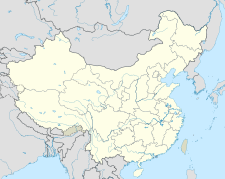Mange Temple
| Mange Temple | |
|---|---|
曼阁佛寺 | |
| Religion | |
| Affiliation | Buddhism |
| Sect | Theravada |
| District | Jinghong |
| Prefecture | Xishuangbanna Dai Autonomous Prefecture |
| Province | Yunnan |
| Location | |
| Country | China |
| Prefecture | Xishuangbanna Dai Autonomous Prefecture |
| Geographic coordinates | 22°01′51″N 100°48′17″E / 22.03082°N 100.804721°E |
| Architecture | |
| Style | Chinese architecture |
| Date established | 1477 |
Mange Temple (simplified Chinese: 曼阁佛寺; traditional Chinese: 曼閣佛寺; pinyin: Màngé Fó Sì) is a Buddhist temple located in Jinghong of Xishuangbanna Dai Autonomous Prefecture, Yunnan, China. Covering an area of 1,300-square-metre (0.32-acre), the temple is bordered by Lancang River in the north. Built in 1477, the temple is one of the oldest temples in Xishuangbanna Dai Autonomous Prefecture.[1]
History
[edit]According to historic records, the temple was first built in 1477, in the 13th year of Chenghua period (1465–1487) in the Ming dynasty (1368–1644), with a history of more than 500 years.[2]
Architecture
[edit]The temple consists of more than 7 buildings. The complex includes the following halls: Main Hall, Scripture Hall, Monk's Houses, Drum tower, Ordination Hall, corridors and door kiosks.[1]
Main Hall
[edit]The main hall also known as "Buddha Hall", is an 11-metre (36 ft) long and 10-metre (33 ft) wide building with double eaves, three slopes and no columns (无柱重檐三面坡建筑). The spectacular Dai style roof is high and steep in slopes because it is surrounded by 16 red painted ailanthus wood columns with lacquered flower patterns. They are decorated with dedicate and beautiful sparrow braces and hanging fascia. The ceiling is drawn with pretty patterns with phenomenal Dai style characteristic. On the walls are paintings with stories of Sakyamuni's becoming Buddha, which are bright in color, fluent in lines and with the style of Dai frescos. They are covered with colorful frescos depicting the vivid and lively images of Chinese dragons, white elephants, phoenixes, peacocks and female celestials.[1][2][3]
In the center of the main hall enshrines a 4-metre (13 ft) high gilded statue of Sakyamuni. The various statues of Buddha and animals are placed in front of the statue of Sakyamuni. Before the statue of Sakyamuni, long flags which are known as Dong in Dai language are hung from the beams, 4-metre (13 ft) in length, they have colorful patterns and flying silver and gold foil streamers hanging down from the beams.[1][4]
Ordination Hall
[edit]The Ordination Hall is an 5-metre (16 ft) long and 3.75-metre (12.3 ft) wide building with double eaves, three slopes and no columns. A 1.7-metre (5 ft 7 in) high sumeru throne is placed in the middle of the hall. A 0.3-metre (1 ft 0 in) high statue of Sakyamuni is sitting on the sumeru throne.
References
[edit]- ^ a b c d Zi Yan (2012). Famous Temples in China (in English and Chinese). Hefei, Anhui: Huangshan Publishing House. pp. 166–168. ISBN 978-7-5461-3146-7.
- ^ a b Yang Deming (2017-07-09). 景洪曼阁佛寺 [Mange Temple in Jinghong]. Yunnan Daily (in Chinese).
- ^ 曼阁佛寺:南传佛教的代表寺院 [Mange Temple, A Representative Temple of Theravada Buddhism]. iFeng (in Chinese). 2011-12-22.
- ^ 中国古建摄影攻略:在版纳邂逅金色佛光 [Photography strategy of Chinese ancient architecture, encountering golden light of Buddha in Xishuangbanna Dai Autonomous Prefecture]. 163.com (in Chinese). 2014-04-03.


